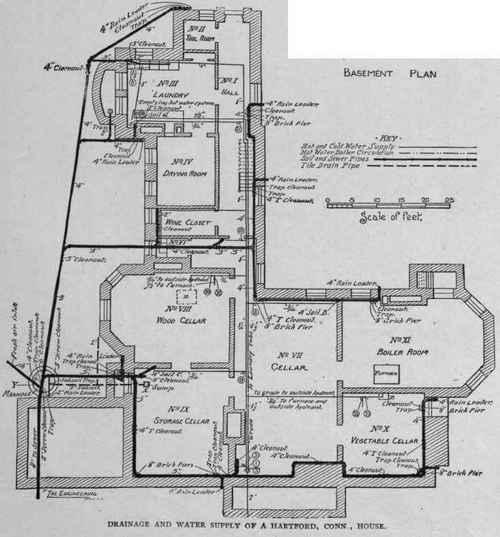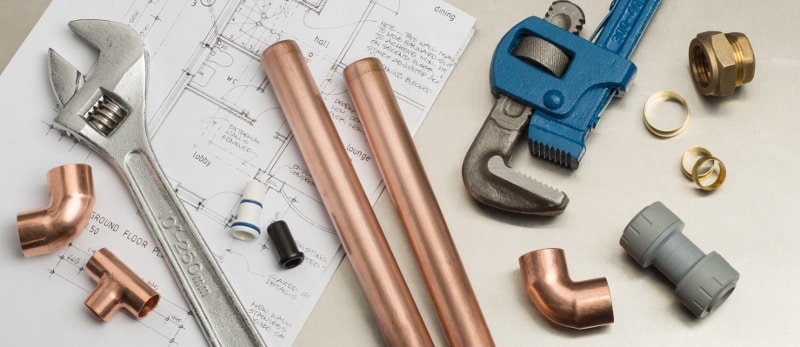A Guide to Your House's Plumbing System Anatomy
A Guide to Your House's Plumbing System Anatomy
Blog Article
What are your ideas about Exploring Your Homes Plumbing Anatomy?

Comprehending just how your home's pipes system works is vital for each house owner. From providing clean water for alcohol consumption, cooking, and bathing to safely eliminating wastewater, a well-kept pipes system is important for your household's health and comfort. In this thorough guide, we'll check out the intricate network that makes up your home's plumbing and offer tips on upkeep, upgrades, and handling typical issues.
Intro
Your home's pipes system is greater than just a network of pipelines; it's a complex system that ensures you have access to clean water and reliable wastewater elimination. Knowing its components and exactly how they interact can aid you avoid expensive repair services and make certain every little thing runs efficiently.
Fundamental Components of a Pipes System
Pipes and Tubes
At the heart of your pipes system are the pipelines and tubes that carry water throughout your home. These can be made of numerous materials such as copper, PVC, or PEX, each with its advantages in terms of toughness and cost-effectiveness.
Fixtures: Sinks, Toilets, Showers, and so on.
Components like sinks, bathrooms, showers, and bathtubs are where water is utilized in your house. Comprehending how these components link to the plumbing system assists in identifying issues and intending upgrades.
Shutoffs and Shut-off Factors
Shutoffs control the circulation of water in your pipes system. Shut-off shutoffs are essential during emergencies or when you need to make repairs, allowing you to separate parts of the system without interfering with water flow to the entire house.
Supply Of Water System
Main Water Line
The main water line connects your home to the metropolitan water or an exclusive well. It's where water enters your home and is dispersed to different fixtures.
Water Meter and Pressure Regulator
The water meter measures your water use, while a stress regulator makes certain that water moves at a risk-free pressure throughout your home's plumbing system, preventing damages to pipelines and fixtures.
Cold Water vs. Hot Water Lines
Recognizing the distinction between cold water lines, which provide water straight from the primary, and hot water lines, which bring heated water from the hot water heater, assists in troubleshooting and preparing for upgrades.
Water drainage System
Drain Pipes and Traps
Drain pipelines lug wastewater away from sinks, showers, and toilets to the sewage system or sewage-disposal tank. Traps prevent sewage system gases from entering your home and likewise catch debris that could create blockages.
Ventilation Pipelines
Ventilation pipelines enable air into the water drainage system, stopping suction that could reduce drain and cause catches to vacant. Correct ventilation is essential for keeping the integrity of your pipes system.
Significance of Appropriate Drainage
Ensuring correct water drainage stops backups and water damage. Regularly cleaning up drains and preserving traps can avoid pricey repairs and extend the life of your pipes system.
Water Heating Unit
Kinds Of Hot Water Heater
Water heaters can be tankless or standard tank-style. Tankless heating units heat water on demand, while containers keep heated water for immediate usage.
Exactly How Water Heaters Attach to the Pipes System
Recognizing how hot water heater attach to both the cold water supply and hot water distribution lines aids in diagnosing issues like not enough hot water or leaks.
Upkeep Tips for Water Heaters
Routinely flushing your hot water heater to get rid of sediment, checking the temperature level setups, and examining for leakages can extend its life expectancy and improve power efficiency.
Usual Plumbing Issues
Leaks and Their Causes
Leaks can happen as a result of maturing pipes, loose fittings, or high water stress. Resolving leaks quickly protects against water damage and mold growth.
Clogs and Obstructions
Clogs in drains pipes and toilets are typically triggered by flushing non-flushable products or an accumulation of oil and hair. Using drainpipe displays and being mindful of what decreases your drains pipes can protect against blockages.
Indications of Plumbing Problems to Watch For
Low water stress, sluggish drains pipes, foul odors, or uncommonly high water bills are signs of prospective pipes problems that ought to be attended to quickly.
Plumbing Upkeep Tips
Routine Assessments and Checks
Arrange yearly pipes inspections to catch problems early. Seek signs of leaks, corrosion, or mineral accumulation in taps and showerheads.
Do It Yourself Maintenance Tasks
Simple tasks like cleansing tap aerators, looking for bathroom leakages utilizing color tablets, or shielding subjected pipelines in cold climates can stop significant pipes issues.
When to Call a Specialist Plumbing
Know when a pipes problem requires specialist experience. Trying complicated repair services without appropriate understanding can lead to even more damages and greater fixing costs.
Updating Your Plumbing System
Reasons for Updating
Updating to water-efficient fixtures or replacing old pipelines can enhance water high quality, decrease water bills, and raise the worth of your home.
Modern Pipes Technologies and Their Benefits
Explore technologies like clever leak detectors, water-saving bathrooms, and energy-efficient water heaters that can save cash and minimize environmental impact.
Price Factors To Consider and ROI
Determine the upfront prices versus long-term savings when thinking about plumbing upgrades. Several upgrades pay for themselves via decreased energy bills and less repair services.
Environmental Influence and Preservation
Water-Saving Fixtures and Devices
Installing low-flow taps, showerheads, and toilets can dramatically minimize water use without sacrificing efficiency.
Tips for Minimizing Water Use
Basic behaviors like taking care of leaks without delay, taking shorter showers, and running complete tons of laundry and meals can preserve water and lower your energy expenses.
Eco-Friendly Plumbing Options
Consider lasting plumbing materials like bamboo for flooring, which is durable and environmentally friendly, or recycled glass for kitchen counters.
Emergency Preparedness
Steps to Take During a Pipes Emergency
Know where your shut-off shutoffs are located and just how to turn off the water system in case of a burst pipe or major leakage.
Value of Having Emergency Calls Helpful
Maintain get in touch with details for regional plumbers or emergency solutions easily available for fast response during a pipes dilemma.
DIY Emergency Fixes (When Relevant).
Momentary fixes like making use of duct tape to spot a leaking pipeline or placing a container under a dripping tap can minimize damage up until an expert plumber arrives.
Conclusion.
Comprehending the makeup of your home's pipes system empowers you to preserve it successfully, conserving money and time on fixings. By following regular maintenance routines and staying notified regarding modern-day plumbing technologies, you can ensure your pipes system runs successfully for years to come.
HOW YOUR PLUMBING SYSTEM WORKS
Which Pipes Do What?
Blue lines = fresh water supply entering the building
Red lines = hot water supply entering the building
Grey lines = pipes carrying waste away from the building and venting pipes carrying gases away from the building (through the roof)
YOUR MAIN PLUMBING SYSTEMS
There are two main plumbing systems that support your home s basic plumbing needs one that brings clean water into your home, and one that sends dirty water away from your home. Connected to the toilet, bath, shower, and other faucets in your home, these two systems keep your water flowing in the right directions.
ACCESSING FRESH WATER
Fresh and clean water is brought into your home through the main water supply line . Filtered through one pipe, this water is pressured to flow into the various fixtures in your home at any given time.
This water can be sourced from a well located on your property, a pond or river (mostly cottages), or, as in most cases, from the city s municipal water treatment centre. However, it is important to note that water that is untreated, such as the water siphoned from ponds or rivers, may not be safe to drink. Personal water supplies always need to be treated for hardness and contaminants before consumed.
MUNICIPAL WATER SUPPLIES
Improve taste and odour
Remove sediment
Eliminate hardness
Reduce chlorine
COLD WATER SUPPLY VS. HOT WATER SUPPLY
Cold water flows into your home or building through the service line, which then distributes hot or cold water to your fixtures. This line is most commonly run through a central column that runs floor to floor. Hot water runs in short and straight pipes as the longer the pipeline, the more heat that will be lost in the transfer. Having shorter pipes also allows residents to access hot water more quickly.
WASTE WATER SYSTEM
Your wastewater system is divided into two parts pipes that send wastewater away from your home and venting pipes that send sewer gas away from your home. Sewage water travels through pipes that flush the water and waste towards local sewers that are operated and managed by your city or town. Most sewer systems rely on gravity to move the wastewater to where it needs to go.
The further away from your toilet or sink, the larger wastewater pipes become. This allows for waste to be disposed of from various parts of your home or business at once without pipe blockages. The angle and flow of these pipes are also essential for keeping your waste pipes clear of build up.
https://harrisplumbing.ca/how-your-home-plumbing-system-works/

HOW YOUR PLUMBING SYSTEM WORKS
Which Pipes Do What?
YOUR MAIN PLUMBING SYSTEMS
There are two main plumbing systems that support your home s basic plumbing needs one that brings clean water into your home, and one that sends dirty water away from your home. Connected to the toilet, bath, shower, and other faucets in your home, these two systems keep your water flowing in the right directions.
ACCESSING FRESH WATER
Fresh and clean water is brought into your home through the main water supply line . Filtered through one pipe, this water is pressured to flow into the various fixtures in your home at any given time.
This water can be sourced from a well located on your property, a pond or river (mostly cottages), or, as in most cases, from the city s municipal water treatment centre. However, it is important to note that water that is untreated, such as the water siphoned from ponds or rivers, may not be safe to drink. Personal water supplies always need to be treated for hardness and contaminants before consumed.
MUNICIPAL WATER SUPPLIES
COLD WATER SUPPLY VS. HOT WATER SUPPLY
Cold water flows into your home or building through the service line, which then distributes hot or cold water to your fixtures. This line is most commonly run through a central column that runs floor to floor. Hot water runs in short and straight pipes as the longer the pipeline, the more heat that will be lost in the transfer. Having shorter pipes also allows residents to access hot water more quickly.
WASTE WATER SYSTEM
Your wastewater system is divided into two parts pipes that send wastewater away from your home and venting pipes that send sewer gas away from your home. Sewage water travels through pipes that flush the water and waste towards local sewers that are operated and managed by your city or town. Most sewer systems rely on gravity to move the wastewater to where it needs to go.
The further away from your toilet or sink, the larger wastewater pipes become. This allows for waste to be disposed of from various parts of your home or business at once without pipe blockages. The angle and flow of these pipes are also essential for keeping your waste pipes clear of build up.
https://harrisplumbing.ca/how-your-home-plumbing-system-works/
We were introduced to that editorial about Plumbing Installation 101: All You Need to Know through an acquaintance on our other domain. Appreciated our review? Please share it. Let somebody else find it. Thank you for taking the time to read it.
Check It Out Report this page